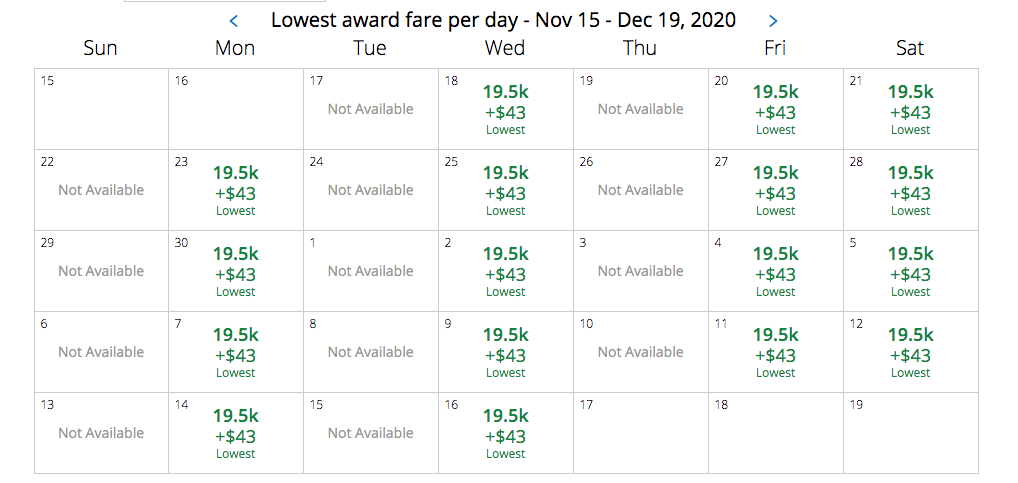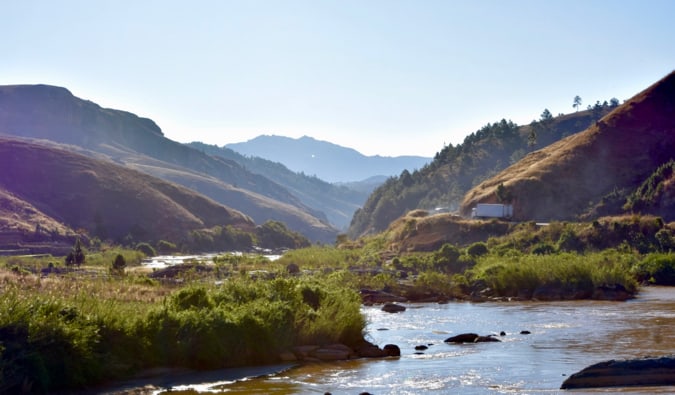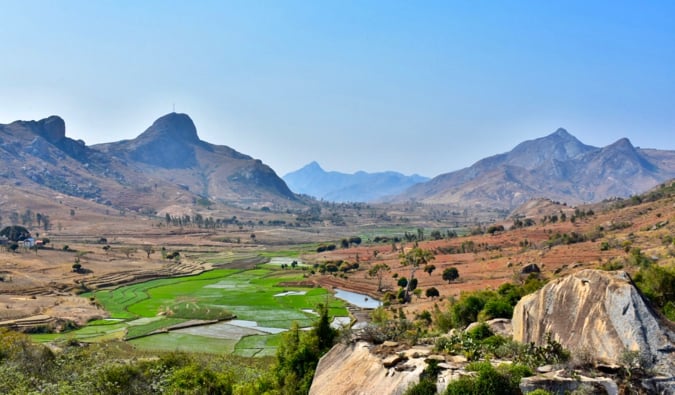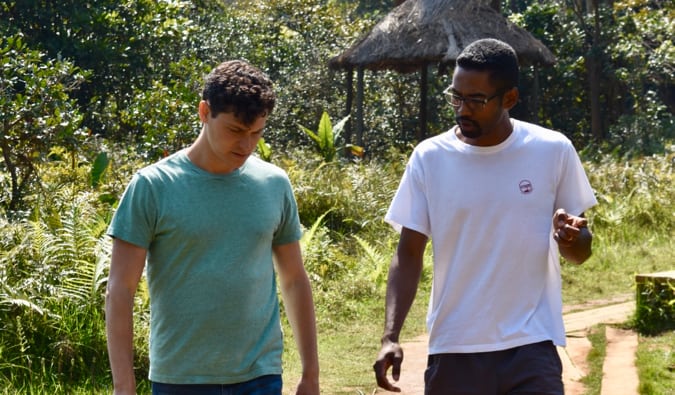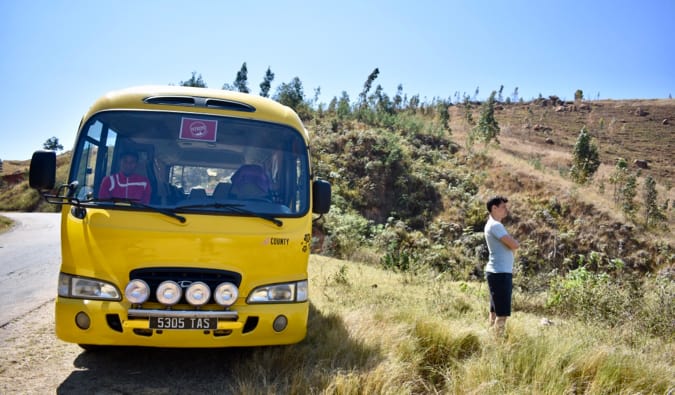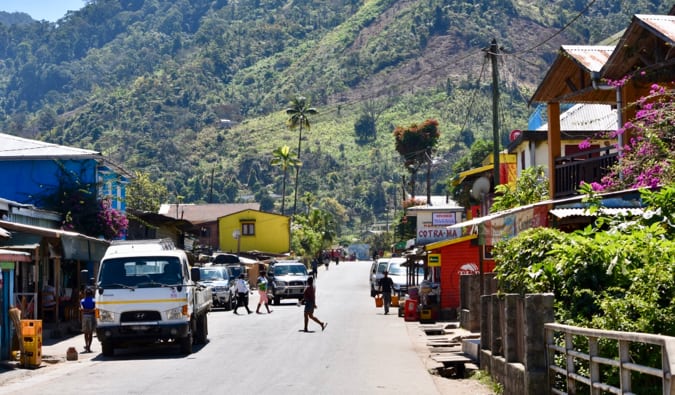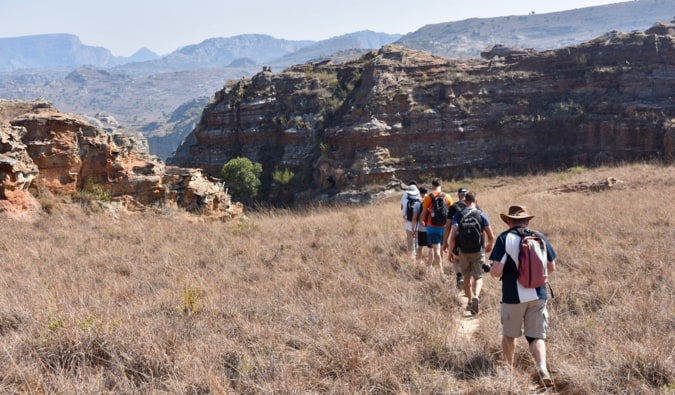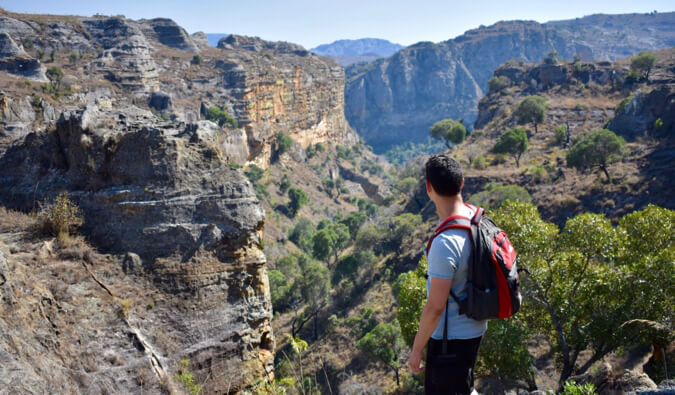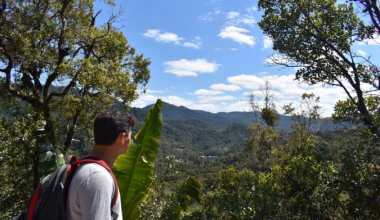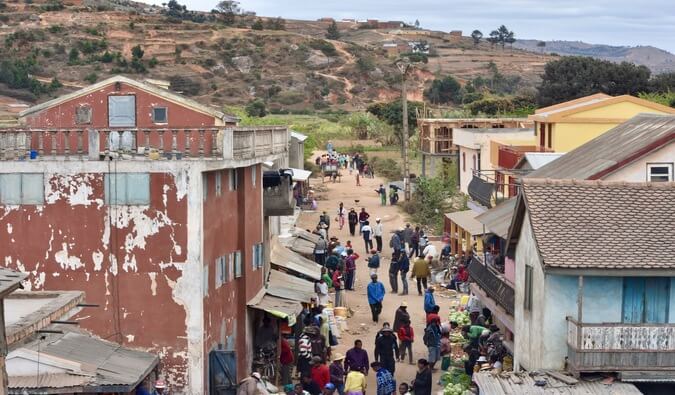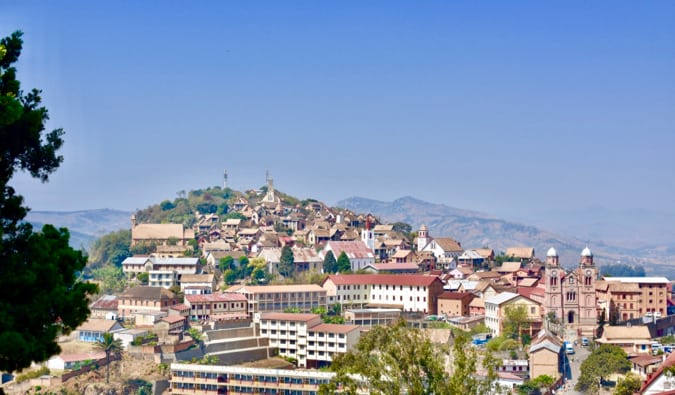
Updated: 8/31/20 | August 31st, 2020
Madagascar. It’s more than an inaccurate (but fun) DreamWorks movie.
Located off the eastern coast of Africa, this island, nearly the size of France and the third-largest in the world, has a population over 26 million but sees less than 300,000 tourists a year.
I spent two weeks there with Intrepid Travel and was surprised by how few tourists there were as well as by just how difficult the country was to travel around. The roads are so bad it can take up to eight hours to go 250 km (155 miles)!
But soon it became clear why there were so few tourists: getting to the country is expensive, there’s very little information about it online, few organized activities, and only a couple hostels, tourism information centers, helpful signs, or anything that would be considered a “tourist infrastructure” (and sadly, very little infrastructure at all). Madagascar’s tourism caters to older Europeans who visit expensive beach resorts or take organized tours and move around the country in a little bubble. Nary a backpacker did I see on my trip.
Moreover, it’s a country ravaged by poverty, corruption, and natural disaster. Travelers unwilling to get off the beaten path (which is most people) usually don’t end up here.
Yet Madagascar is a raw and beautiful destination that blew me away in so many ways. It’s cheap once you get there, your tourist dollars can create a really positive impact, and there are few crowds and many cute lemurs and majestic landscapes, which you get virtually to yourself!
How to Get There
The first thing you need to know is that getting to Madagascar is not easy. Direct flights are only available from a handful of major destinations (including Paris, Istanbul, and Johannesburg) as well as less-visited countries like Seychelles, Mauritius, Kenya, and Ethiopia.
Additionally, most of these destinations only offer a limited amount of flights per week.
I jumped on a flight deal to Johannesburg ($630 USD for New York to Johannesburg and then onward to Vienna) but that was a stupid thing to do because, given the price of flights from Johannesburg to Madagascar (I paid $800 USD round-trip), it ended costing me more than just booking a direct ticket to Madagascar.
I was pretty stupid not looking up flights beforehand. I could have bought a round trip ticket from the US for less (and from Paris for way less.) Here’s a chart for prices from New York City in January 2021 to help give you a sense of what to expect when booking your ticket:
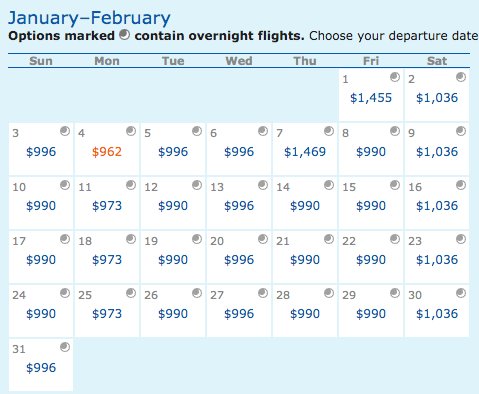
For a flight from the United States to Madagascar, you’re looking at spending at least $1,000 USD for a round-trip flight. Keep in mind these prices are for the rainy season in December/January. During the high season (also the dry season), you’re looking at flights closer to $1,600-2,000 USD from New York City and $800-1,100 USD from Europe.
From Canada? Prices start around $1,200 CAD in the low season.
You’re looking at spending at least $500 USD round-trip on a flight from Johannesburg (more if it’s high season).
However, it’s not all bad news. From Paris, Air France offers direct round-trip flights for around $700 USD. And there are a few travel hacking opportunities. With some planning, you can find a reward flight. You only need 30,000 miles each way from Europe, and Air France has a decent availability (but if you miss the 30,000-point option, you’ll be looking at 60-90,000 points each way).
United has very sporadic reward flights on partners starting at 19,500 miles each way. Flights are only bookable on certain days, however, and only in the economy. On the plus side, the price in miles is the same in both the high season and the low season.
So it takes some work to get there, but if you can string together some flight deals as well as mile opportunities, you can lower the cost to an affordable(ish) level.
Here are some websites you can use to find cheap flight deals:
How to Get Around Madagascar
Organized tours are the most common way to visit the country. One guide told me that about 80% of visitors come on organized tours and the other 20% hire a private driver to get around. (Most tourists are older and heavily European.)
I think that many younger travelers stay away because getting to the country or booking a tour is so expensive. Plus, there’s just not much free information available on Madagascar.
But let’s change that and talk about how to visit the country.
Organized Tours
A 14-day tour will cost $2,400–4,400 USD. You’ll stay in mid-range hotels (private bathrooms, hot water, breakfast, and maybe even a pool) and have your own bus with a driver and local guide. You’ll also get private guides at each park who will explain what you’re seeing, help spot animals, and give some added context on the destination.
Most of the tours follow the same route, hitting all the big parks and destinations in the center of the country, with added paid add-ons to other parts of the country.
I went with Intrepid Travel on their Experience Madagascar tour as part of my partnership with them. Our guide Patrick was a phenomenal resource, answering all my questions, providing advice, and giving tips on what to see and do in this country that lacks a lot of resources to research.
If it were up to me, I would have focused the trip’s itinerary more. I think Intrepid sometimes tries to do too much. While I liked everything we did, I wish there had been more time visiting each place and less time driving (though if Madagascar had proper infrastructure that wouldn’t have been an issue).
Independent Travel
Madagascar is a difficult place to visit solo. There’s little tourist infrastructure or hostels (which makes sense given how inexpensive hotels and guesthouses are here) and public buses don’t go to many cities and national parks. You’ll need to know French, too, as English is barely spoken (even though English is an official language).
In my opinion, this makes it rather arduous to get around without any assistance.
But could you travel around on your own? Sure! But I think you’d need to be an experienced traveler, really OK being pushed out of your comfort zone, and in absolutely no rush, because getting around on a budget will take time.
Since the roads are really bad, getting from point A to B is a challenge. In a public taxi brouse (small van packed to the gills with people), you’ll move slowly. Buses go when they are full. There’s no set timetable. Sometimes they show up; more often than not, they don’t.
However, seeing the condition of the buses and how many people they cram in there, plus the number of accidents on the road, I’m not sure I’d even get in one. I wouldn’t want to spend 24 hours packed like a chicken in a van with no air conditioning (and sometimes not even windows).
Renting a car and driver costs $75 USD a day (or slightly more if you want 4WD) and is the most popular option for people looking to go on their own (and not wanting to wait for the buses). While you could drive on your own, most rental companies require that a driver accompany you.
You can also fly around the island, but there’s only one airline (Air Madagascar), and most tickets cost at least $250-300 USD, so if you’re on a budget, flying just isn’t feasible. Plus, they cancel flights often without notice.
So, What Should You Do?
If you’re really looking for some rugged, old-school independent travel, Madagascar is the place to do it. If you have lots of time and are up for a real challenge, go solo — and learn some French! (I really can’t stress the need to know French. Outside the big towns and a few tourist areas, English is barely spoken.)
You’ll cover slightly more ground and have a lot more freedom if you rent a car and driver. There’s plenty of cheap guesthouses and restaurants around so you won’t need to look far and wide for a place to stay or a meal.
If you aren’t looking for that kind of rugged experience and would like something more organized, a tour is the best — and really only — option. I wanted a tour to help me get the lay of the land and answer all my questions about the country. I don’t speak French nor had a lot of time. A tour was a great orientation to a country that was an enigma to me. It was a wonderful way to meet people in a destination with few independent travelers.
(One thing to remember is that the clientele of the tours here is older and the tours cater to that in their itineraries, activities, and accommodation. The tours here aren’t designed for active backpackers.)
If I went back, I’d go by myself and explore with a car but I’m glad I went with a tour on my first visit.
Is Madagascar Safe?
When I was wandering around, I never once felt unsafe. I was more of a curiosity than anything else since they see so few tourists, especially those not ensconced in a bus. There are a lot of beggars, especially kids, and you have to just keep saying no and walking away. The taxi drivers here take no for an answer and no one really bugs you.
That said, crime is rife throughout the country and not one local I knew recommended going out after dark. They don’t even do it. In fact, many hotels in the capital of Antananarivo hire escorts to take people from the hotel to bars or restaurants.
During the day and, especially in smaller villages, walking around is perfectly fine. At night, I would use a lot more caution, especially in the capital.
What are Prices Like?
Though getting to the country is expensive, once you are there everything is incredibly cheap. Your money goes a long, long way in Madagascar. I went to a local market and spent 100 ARY on a spring roll. After realizing that there are 3,000 ARY to the dollar, that meant I had paid just three cents. As I was still hungry, I bought 15 more.
Even when you are eating at the hotel restaurants the tours go to, most meals aren’t more than $4 USD. In regular, local restaurants, they are half that price.
Madagascar food is mostly chicken, zebu (a type of cattle), pork, stews, and rice. LOTS OF RICE. (Get the Zebu in a stew. It’s better that way.) There’s also a lot of surprisingly good pizza in this country. You’ll definitely need to know French if you go into the non-international places (or travel outside of the cities).
Even on the road, there are a lot of restaurants (again, knowing French is going to be key here, especially outside the capital Antananarivo). Hotels are $20-50 USD per night (on the cheaper range outside the capital). You can easily find accommodation on booking.com. There’s plenty of accommodation listed on that website.
Here are some typical prices:
- Meals at restaurants that cater to tourists – 12,000-30,000 MGA ($3-8 USD)
- Meals at regular, local restaurants – 6,500 MGA ($1.75 USD)
- Street snacks – 10-200 MGA (up to 5 cents US) (Be sure to try nem (spring rolls). They are incredible!)
- Accommodation – 65,000-160,000 MGA per night ($20-50 USD)
- Car with a driver – 285,000 MGA a day ($75 USD)
- Grocery prices – 11,000-20,000 MGA ($3-5 USD) (This would get you a kilo of rice, some zebu, and a variety of vegetables.)
- SIM Card – 4,000 MGA ($1 USD) and 30,000 MGA ($8 USD) per 2 GB of data.
- Park entrance fees – 55,000 MGA ($15 USD) plus 20,000 MGA ($5.50 USD) for a guide
- Local mini buses – 10,000-20,000 MGA ($2.50-5 USD)
Madagascar was a beautiful, raw, and enchanting country. There’s no place like it on earth.
Far off the tourist trail, this a destination where your inner Indiana Jones or Anthony Bourdain can be set free to explore. I’m so glad I went, and though the old traveler adage is “I can’t wait to go back,” I suspect that my visit to Madagascar will be the only one in my lifetime. I hope I’m wrong, but given the difficulty of getting there, it really can be a once-in-a-lifetime trip.
And I do hope you make it in your lifetime!
Book Your Trip to Madagascar: Logistical Tips and Tricks
Book Your Flight
Use Skyscanner or Momondo to find a cheap flight. They are my two favorite search engines because they search websites and airlines around the globe so you always know no stone is left unturned. Start with Skyscanner first though because they have the biggest reach!
Book Your Accommodation
You can book your hostel with Hostelworld as they have the biggest inventory and best deals. If you want to stay somewhere other than a hostel, use Booking.com as they consistently return the cheapest rates for guesthouses and cheap hotels.
Don’t Forget Travel Insurance
Travel insurance will protect you against illness, injury, theft, and cancellations. It’s comprehensive protection in case anything goes wrong. I never go on a trip without it as I’ve had to use it many times in the past. My favorite companies that offer the best service and value are:
- Safety Wing (for everyone below 70)
- Insure My Trip (for those over 70)
- Medjet (for additional repatriation coverage)
Looking for the Best Companies to Save Money With?
Check out my resource page for the best companies to use when you travel. I list all the ones I use to save money when I’m on the road. They will save you money when you travel too.
Want More Information on Madagascar?
Be sure to visit our robust destination guide on Madagascar for even more planning tips!
Note: I went to Madagascar with Intrepid Travel as part of our ongoing partnership. They paid for the tour and my expenses during the trip. I paid for my flights to and from Madagascar.
